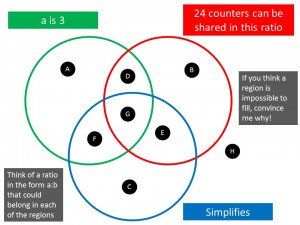You can view all the posts in the epic “Writing a Maths Scheme of Work” series on this page. It’s kind of like Game of Thrones, only with slightly less nudity and dragons.
So, we have officially (almost!) reached the end of our first full academic year with our brand new maths Scheme of Work. So, I thought it would be useful (more for myself, than anything) to take a quick look back on the main components of the Scheme of Work and try to decide if they have been a success or not. So, here we go…
Content and Order
As I explained way back in Post 5, we wanted to strip back a lot of the repeated content that is apparent in many schemes of work. We wanted to break the cycle whereby students end up doing 2 weeks of fractions in Year 7, then another two weeks in Year 8, then again in Year 9, and so on, until they reach Year 11 and still cannot do fractions. Instead we wanted to go into greater depth into all subjects, and we created the time to do this by essentially halving the content covered each year. So, students would only cover, say, Fractions in Year 7, and not revisit it formally until Year 9. The extra time gained on each topic would allow each class to complete one compulsory rich task, go deeper into the topic, and properly review any areas of weakness revealed by homework performance.
And of course, it is not as if the students would go a year without seeing fractions, as they would pop up regularly in the Review sections of our homeworks, and creep nicely into topics such as Probability and Solving Equations. That is the why the order of the scheme was so important for us.
So, has this worked? Well, in the main, I would say yes.
Some of the rich tasks need tweaking (more on that below), but staff seem to have appreciated having more time on a topic. It has made planning a little more difficult, because you may need to plan a series of 8 lessons on a topic instead of the usual 4. But we have provided support in delivering topics in greater depth, as well as additional rich tasks and suggestions for each topic. Lessons have been more fun, and staff have had more opportunities to take risks. And if a class has exhausted all possible avenues for a given topic, there are lots of additional tasks and activities available focussing on other core skills. Crucially, everyone moves onto the next topic at the same time to aid our planning and administration.
We will be sticking with this same idea next year. We will just tweak the time allocated to some topics. For example, towards the end of my third week on circles with Year 8, I never wanted to see that stupid shape again.
And, just in case it is useful to you, here is the order we have settled upon for the next academic year, with content descriptions taken from Kangaroo Maths.
But if this lovely Scheme of Work Builder from OCR had been available sooner, I think we would have started with that!
Rich Tasks
A key component of our Scheme of Work have been our rich tasks. I really wanted avoid what I call “The Lesson Lottery”, whereby some students get a raw deal and miss out on doing a high-quality, engaging activity, just because their teacher doesn’t want to do it. But at the same time, I am acutely aware of the dangers of dictating to teachers exactly what they should be doing, and the major disadvantages of stifling individual creativity and choice. I would hate to be told what to do, so why should I tell others? So, we set upon the policy of allowing teachers to deliver topic units however they wanted, but each topic unit (in Years 7 to 9) would contain one compulsory rich task that each student in each class would do.
On the whole, this worked well. We used Departmental Development Time each fortnight to have a look at the rich tasks in advance so teachers could begin to think how to use them best with their classes. Those teachers that bought into this and fully engaged found great success.
One key bit of feedback I received was that staff did not really like the rich tasks that involve lots of cutting, sticking and printing. They much preferred the ones that start with a simple prompt, and then differentiation and progress come from various prompts and lines of inquiry. And this makes sense, because my whole belief around good rich tasks is that a teacher’s time should not be spent planning and preparing resources, but thinking about questions instead. So, I have set about removing the less successful ones from this year and replacing them with tasks that are more simple to prepare for but equally effective. It will be a tricky job, but what else would I want to get up to this summer? 🙂
I have put together 30 of the best Rich Tasks that we use in our Scheme of Work on this page, together with teaching notes and probing questions.
The major sources of the rich tasks I use can be found here.
And from next year, our schemes of work will be littered with my latest rich task obsession… Venn Diagrams! I have written 24 activities based on these beauties which are available here.
Homeworks
I have explained in Post 16 about how our Homeworks work. But, to summarise here, we set one compulsory written homework each fortnight. They consist of 30 marks, 10 of which are for Revision (i.e. questions from topics taught earlier in the year or in previous years), and 20 marks are based on the current topics being taught. These scores are then recorded centrally on a spreadsheet to make comparison and appropriate interventions as easy as possible.
In addition, each week, each year group from 7 to 11 is set a 10 question Diagnostic Question quiz. Again, we have tried to fuse together practise of the current topic being taught, alongside the need for regular practise of past topics. So, we have a balance of 3 questions on the current topic, and 7 that test prior knowledge.
Again, I would argue that our homework policy has worked well. Homeworks are centrally produced and stored, scores are tracked, and both staff and students know what is expected.
However, if I were staring this process from scratch, there are a few new (free!) resources that I would be looking at for help getting started. These are:
Kangaroo Maths – Build a Mathematician
Assessments
As I explained in Post 17, I have not been entirely happy with our assessments this year. I think we have pretty much decided to trial a Foundation paper for Years 7 to 9 for each of their formal assessments from next year, and the reasons are explored in the previous post. However, here is an interesting alternative: Kangaroo Maths – Got It and Test Bank
What have I learned?
Completely rewriting our Year 7 to 9 Schemes of Work (and Year 10 from September) has probably been the biggest individual job I have taken on as a teacher. It started with a philosophy and belief that my Head of Department, Karen, fully supported, and then came the job of making it a practical reality. Not only did this involve getting all the resources and structure in place (if anything, this was the easy part), but also in getting the rest of the department on board and making the necessary tweaks and compromises needed to ensure it was a success.
There have been ups and downs, but when I see our students’ books, or hear our kids talking about what they were doing in maths, or see two colleagues working on a particular line of inquiry for an upcoming rich task, I know it has been worth it.
When I am spending this summer tweaking and improving it, I just need to also convince my wife it has been worth it.
Have a lovely summer
Craig






Wow!
Thank you so much (and please extend to your team) for the generosity of sharing your work. To be fair GOT has you pipped on adventure, nudity and dragons but not on practical usefulness. I have found a plethora of useful links and have been extended in my own thinking. I really appreciate your willingness to share your journey with others and please know that it is not only greatly appreciated but will have an effect beyond what you’ll ever be told about.
Yeah to you guys ( and your long-suffering partners) and thank you again.
Thank you, that’s very kind and very much appreciated. Craig
Like the look of your rich tasks. Which tasks do you slot where into your scheme of work or do you do them in any order for any year group?
Also I see for each year group you have some fun activities for the end of year, are you going to make these available to share?
Great website, one of the best Ive used.
Hi Joanne,
I am going to be working on matching up the rich tasks over the summer, and I might be able to publish a new SOL with the rich tasks on there. In the meantime, we try to match-up rich tasks to appropriate topic areas. The Venn Diagrams are the easiest to match, and things like Tilted Squares will be used with Pythagoras.
Craig
Hi,
What strategies do you use at keystage 3 for intervention? If you have individuals who are not progressing what do you put in place?